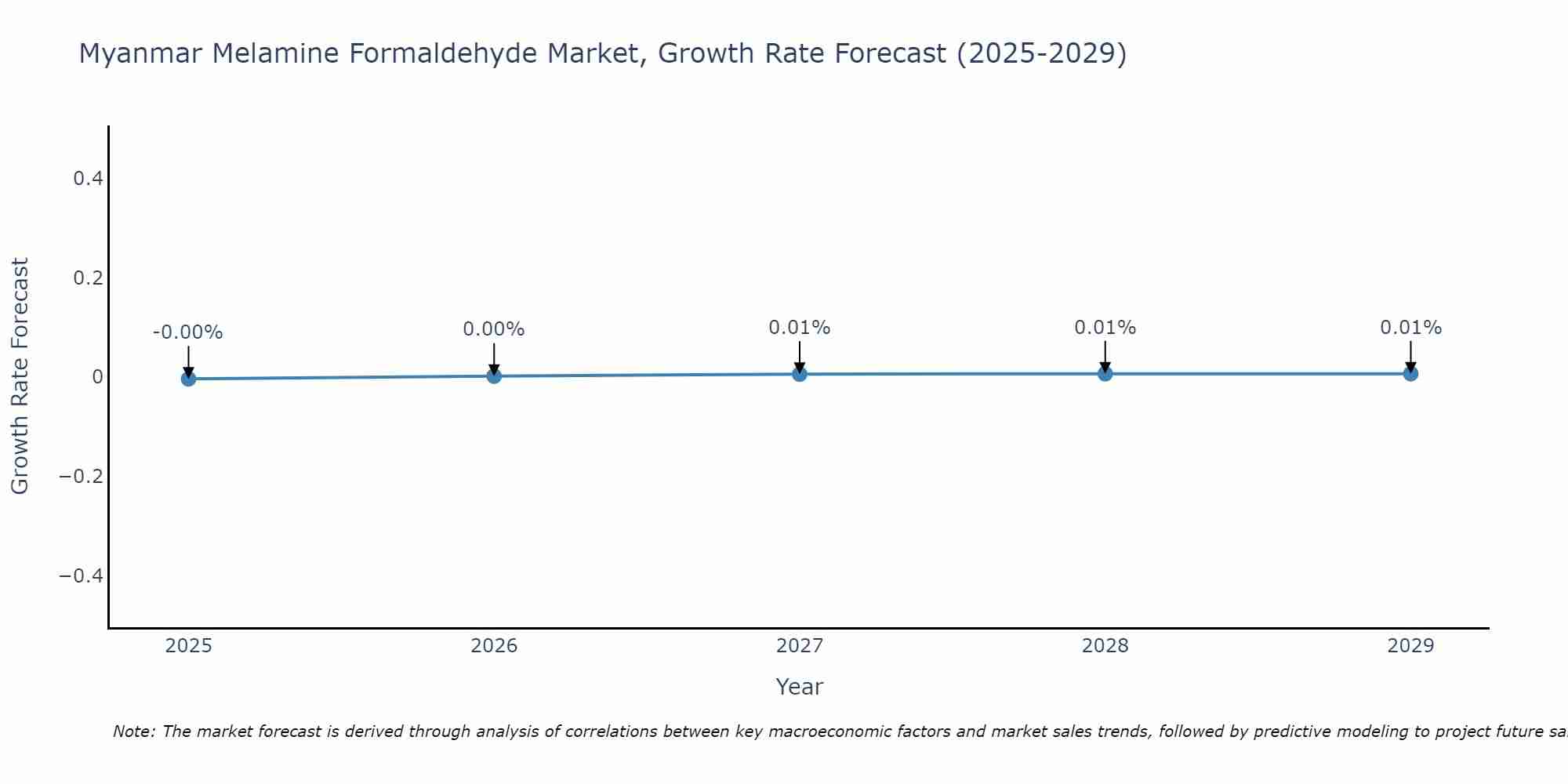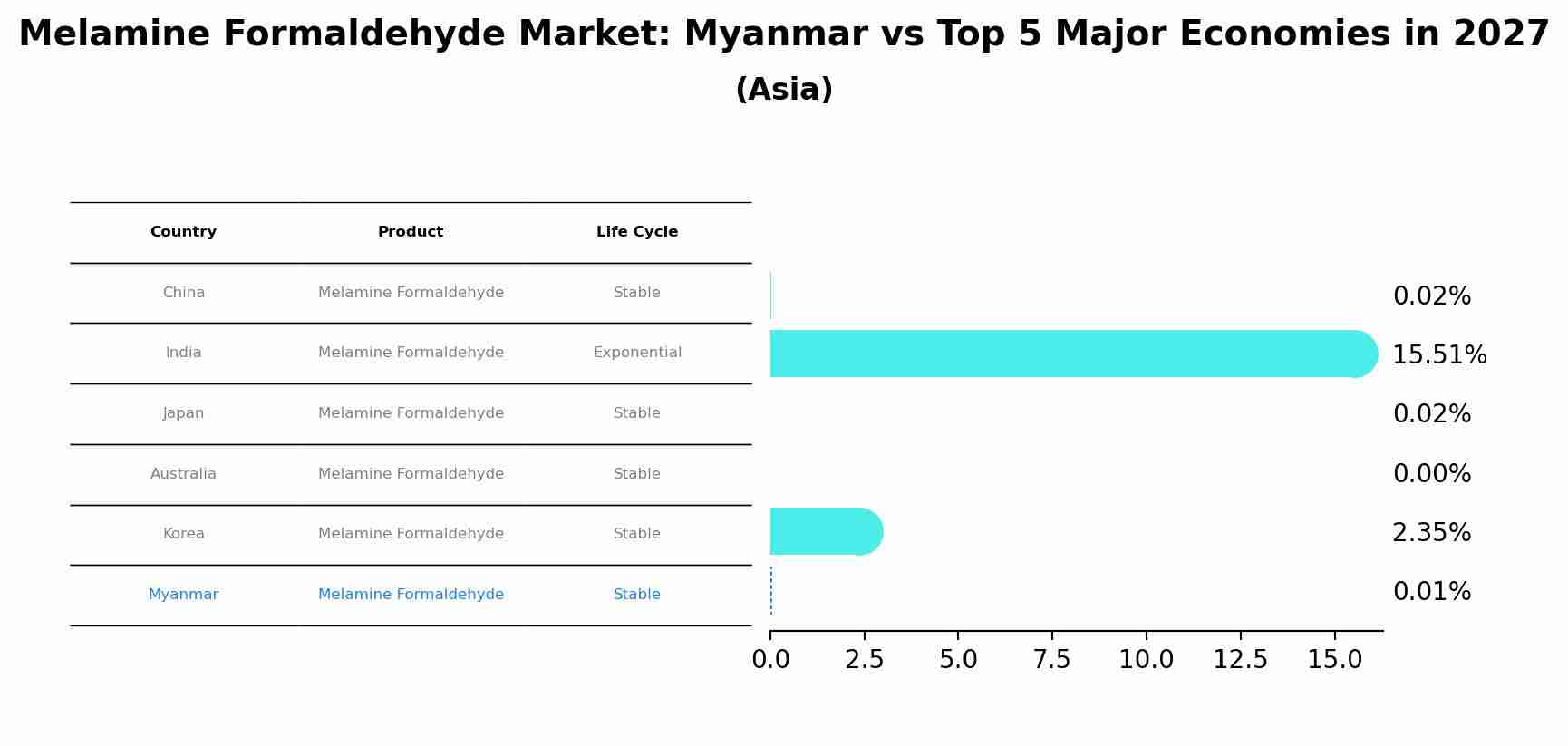Myanmar Melamine Formaldehyde Market (2025-2031) Outlook | Share, Analysis, Size, Growth, Revenue, Trends, Forecast, Industry, Value & Companies
| Product Code: ETC110153 | Publication Date: Jun 2021 | Updated Date: Apr 2025 | Product Type: Report | |
| Publisher: 6Wresearch | Author: Ravi Bhandari | No. of Pages: 70 | No. of Figures: 35 | No. of Tables: 5 |
Myanmar Melamine Formaldehyde Market Size Growth Rate
The Myanmar Melamine Formaldehyde Market is poised for steady growth rate improvements from 2025 to 2029. The growth rate starts at -0.00% in 2025 and reaches 0.01% by 2029.

Melamine Formaldehyde Market: Myanmar vs Top 5 Major Economies in 2027 (Asia)
In the Asia region, the Melamine Formaldehyde market in Myanmar is projected to expand at a stable growth rate of 0.01% by 2027. The largest economy is China, followed by India, Japan, Australia and South Korea.

Myanmar Melamine Formaldehyde Market Overview
Melamine formaldehyde is widely used in the production of laminates, adhesives, and coatings due to its strong bonding properties and resistance to heat and chemicals. The market in Myanmar is expanding with the growth of the construction and furniture industries, which require high-performance materials for various applications.
Drivers of the market
The melamine formaldehyde market in Myanmar is witnessing growth driven by the expanding construction and furniture industries, the demand for durable and moisture-resistant materials, and the increasing adoption of melamine formaldehyde resins in various applications. Melamine formaldehyde resins are widely used as adhesives, laminates, and coatings due to their high strength, heat resistance, and chemical stability. The market expansion is supported by infrastructure development projects, urbanization, and the growing consumer preference for aesthetically pleasing and long-lasting interior furnishings.
Challenges of the market
Challenges in the melamine formaldehyde market include high costs of raw materials and production technologies, making local production less competitive. Limited domestic production capacity and technological expertise also affect the quality and availability of locally produced melamine formaldehyde. Additionally, there is limited awareness and adoption of this compound in various industrial applications. Regulatory barriers and quality control issues further complicate market dynamics, affecting both production and distribution.
Government Policy of the market
Myanmar industrial policies promote the use of melamine formaldehyde in various applications such as laminates and coatings. Regulations ensure product safety and environmental compliance, while incentives are provided for local production and technological advancements in manufacturing processes.
Key Highlights of the Report:
- Myanmar Melamine Formaldehyde Market Outlook
- Market Size of Myanmar Melamine Formaldehyde Market, 2024
- Forecast of Myanmar Melamine Formaldehyde Market, 2031
- Historical Data and Forecast of Myanmar Melamine Formaldehyde Revenues & Volume for the Period 2021-2031
- Myanmar Melamine Formaldehyde Market Trend Evolution
- Myanmar Melamine Formaldehyde Market Drivers and Challenges
- Myanmar Melamine Formaldehyde Price Trends
- Myanmar Melamine Formaldehyde Porter's Five Forces
- Myanmar Melamine Formaldehyde Industry Life Cycle
- Historical Data and Forecast of Myanmar Melamine Formaldehyde Market Revenues & Volume By Type for the Period 2021-2031
- Historical Data and Forecast of Myanmar Melamine Formaldehyde Market Revenues & Volume By Methylated Melamine Formaldehyde Resin for the Period 2021-2031
- Historical Data and Forecast of Myanmar Melamine Formaldehyde Market Revenues & Volume By Non-methylated Melamine Formaldehyde Resin for the Period 2021-2031
- Historical Data and Forecast of Myanmar Melamine Formaldehyde Market Revenues & Volume By Application for the Period 2021-2031
- Historical Data and Forecast of Myanmar Melamine Formaldehyde Market Revenues & Volume By Laminates for the Period 2021-2031
- Historical Data and Forecast of Myanmar Melamine Formaldehyde Market Revenues & Volume By Wood Adhesives for the Period 2021-2031
- Historical Data and Forecast of Myanmar Melamine Formaldehyde Market Revenues & Volume By Molding Compounds for the Period 2021-2031
- Historical Data and Forecast of Myanmar Melamine Formaldehyde Market Revenues & Volume By Paints and Coatings for the Period 2021-2031
- Historical Data and Forecast of Myanmar Melamine Formaldehyde Market Revenues & Volume By Other Applications for the Period 2021-2031
- Myanmar Melamine Formaldehyde Import Export Trade Statistics
- Market Opportunity Assessment By Type
- Market Opportunity Assessment By Application
- Myanmar Melamine Formaldehyde Top Companies Market Share
- Myanmar Melamine Formaldehyde Competitive Benchmarking By Technical and Operational Parameters
- Myanmar Melamine Formaldehyde Company Profiles
- Myanmar Melamine Formaldehyde Key Strategic Recommendations
Frequently Asked Questions About the Market Study (FAQs):
- Single User License$ 1,995
- Department License$ 2,400
- Site License$ 3,120
- Global License$ 3,795
Search
Thought Leadership and Analyst Meet
Our Clients
Related Reports
- Canada Oil and Gas Market (2026-2032) | Share, Segmentation, Value, Industry, Trends, Forecast, Analysis, Size & Revenue, Growth, Competitive Landscape, Outlook, Companies
- Germany Breakfast Food Market (2026-2032) | Industry, Share, Growth, Size, Companies, Value, Analysis, Revenue, Trends, Forecast & Outlook
- Australia Briquette Market (2025-2031) | Growth, Size, Revenue, Forecast, Analysis, Trends, Value, Share, Industry & Companies
- Vietnam System Integrator Market (2025-2031) | Size, Companies, Analysis, Industry, Value, Forecast, Growth, Trends, Revenue & Share
- ASEAN and Thailand Brain Health Supplements Market (2025-2031) | Strategy, Consumer Insights, Analysis, Investment Trends, Opportunities, Growth, Size, Share, Industry, Revenue, Segments, Value, Segmentation, Supply, Forecast, Restraints, Outlook, Competition, Drivers, Trends, Demand, Pricing Analysis, Competitive, Strategic Insights, Companies, Challenges
- ASEAN Bearings Market (2025-2031) | Strategy, Consumer Insights, Analysis, Investment Trends, Opportunities, Growth, Size, Share, Industry, Revenue, Segments, Value, Segmentation, Supply, Forecast, Restraints, Outlook, Competition, Drivers, Trends, Demand, Pricing Analysis, Competitive, Strategic Insights, Companies, Challenges
- Europe Flooring Market (2025-2031) | Outlook, Share, Industry, Trends, Forecast, Companies, Revenue, Size, Analysis, Growth & Value
- Saudi Arabia Manlift Market (2025-2031) | Outlook, Size, Growth, Trends, Companies, Industry, Revenue, Value, Share, Forecast & Analysis
- Uganda Excavator, Crane, and Wheel Loaders Market (2025-2031) | Strategy, Consumer Insights, Analysis, Investment Trends, Opportunities, Growth, Size, Share, Industry, Revenue, Segments, Value, Segmentation, Supply, Forecast, Restraints, Outlook, Competition, Drivers, Trends, Demand, Pricing Analysis, Competitive, Strategic Insights, Companies, Challenges
- Rwanda Excavator, Crane, and Wheel Loaders Market (2025-2031) | Strategy, Consumer Insights, Analysis, Investment Trends, Opportunities, Growth, Size, Share, Industry, Revenue, Segments, Value, Segmentation, Supply, Forecast, Restraints, Outlook, Competition, Drivers, Trends, Demand, Pricing Analysis, Competitive, Strategic Insights, Companies, Challenges
Industry Events and Analyst Meet
Whitepaper
- Middle East & Africa Commercial Security Market Click here to view more.
- Middle East & Africa Fire Safety Systems & Equipment Market Click here to view more.
- GCC Drone Market Click here to view more.
- Middle East Lighting Fixture Market Click here to view more.
- GCC Physical & Perimeter Security Market Click here to view more.
6WResearch In News
- Doha a strategic location for EV manufacturing hub: IPA Qatar
- Demand for luxury TVs surging in the GCC, says Samsung
- Empowering Growth: The Thriving Journey of Bangladesh’s Cable Industry
- Demand for luxury TVs surging in the GCC, says Samsung
- Video call with a traditional healer? Once unthinkable, it’s now common in South Africa
- Intelligent Buildings To Smooth GCC’s Path To Net Zero


















